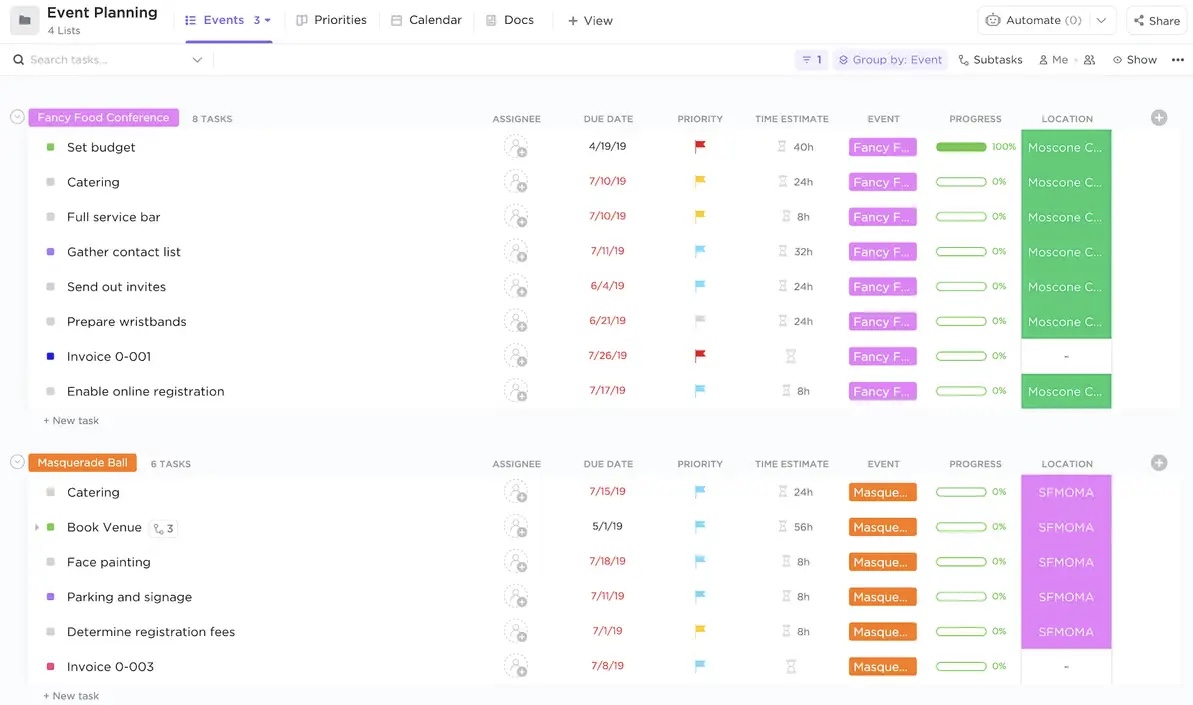لديك الخطة المثالية، والموردون جاهزون، ولأول مرة، يبدو أن كل شيء يسير على ما يرام — إلى أن يتأخر المتحدث الرئيسي بسبب ازدحام المرور، ويحضر متعهد تقديم الطعام الطلب الخطأ، ويطلب أحدهم منك "تحريك المسرح قليلاً"
تجعلك تخطيط الفعاليات في حالة استنفار دائم، لكن إدارة مشاريع الفعاليات تضمن ألا تنتهي في دوامة من الذعر.
تساعدك الأدوات والاستراتيجيات المناسبة على تجنب الفوضى في اللحظات الأخيرة، والحفاظ على تزامن فريقك، والتأكد من أن كل شيء يسير على ما يرام (دون أن تفقد صوابك في هذه العملية).
تحتوي هذه المدونة على العديد من النصائح والأدوات والاستراتيجيات لمساعدتك على التخطيط بشكل أكثر ذكاءً وتقليل التوتر. هيا بنا نبدأ! 🎯
⏰ ملخص في 60 ثانية
تعمل إدارة مشاريع الفعاليات على تبسيط التخطيط والتنفيذ والتنسيق لضمان تقديم فعاليات سلسة. إليك كيفية الحفاظ على التنظيم والتحكم:
- تحديد الأهداف: حدد أهدافًا واضحة وقابلة للقياس لتوجيه تخطيط الفعالية
- إدارة الميزانيات: تتبع النفقات وتكاليف الموردين وأموال الطوارئ
- إنشاء جدول زمني مفصل: قسّم المهام إلى مراحل، بدءًا من التخطيط وحتى المتابعة بعد الحدث
- تنسيق الموردين واللوجستيات: حافظ على وضوح التواصل وتتبع المواعيد النهائية
- التسويق الفعال: استخدم البريد الإلكتروني ووسائل التواصل الاجتماعي والشراكات لزيادة الحضور
- ضمان التنفيذ السلس: قم بوضع جداول زمنية وخطط طوارئ لمنع حدوث أي عوائق
- جمع التعليقات بعد الحدث: راجع الأفكار وحسّن الأحداث المستقبلية
يقدم ClickUp برنامجًا لإدارة الفعاليات يتضمن:
- مهام ClickUp: نظم المهام والجداول الزمنية وتنسيق الموردين في مكان واحد
- ClickUp Chat: حافظ على مركزية الاتصالات من خلال التحديثات والمناقشات في الوقت الفعلي
- لوحات معلومات ClickUp: تتبع الميزانيات والجداول الزمنية وتقدم الفعالية من خلال تقارير قابلة للتخصيص
- ClickUp Automations: تبسيط توزيع المهام والتذكيرات والموافقات
- قوالب ClickUp: سير عمل مسبق الإعداد لتخطيط الأحداث من أجل إعداد سريع وفعال
ما هي إدارة مشاريع الفعاليات؟
إدارة مشاريع الفعاليات هي التخطيط الاستراتيجي للفعاليات وتنفيذها، مع ضمان توافق كل التفاصيل مع الأهداف العامة. وتشمل تحديد نطاق الفعالية، ووضع أهداف واضحة، وتنسيق كل التفاصيل، بدءًا من الميزانية والجدولة وحتى تخصيص الموارد وإدارة المخاطر.
الفرق بين إدارة المشاريع العامة وإدارة مشاريع الفعاليات
على عكس إدارة المشاريع العامة، التي قد تتناول العمليات الجارية أو المبادرات طويلة الأجل، فإن إدارة مشاريع الفعاليات هي بطبيعتها مؤقتة وديناميكية، وتركز على تقديم تجربة لا تُنسى في إطار زمني محدد.
أحد الاختلافات الرئيسية هو مستوى عدم القدرة على التنبؤ. تتطلب الفعاليات حل المشكلات في الوقت الفعلي، ووضع خطط طوارئ، والتكيف مع التغييرات في اللحظة الأخيرة، مثل إلغاء الموردين أو الظروف الجوية غير المتوقعة.
تتطلب هذه التخصصات المتخصصة تعاونًا سلسًا بين الفرق الداخلية والموردين الخارجيين وأصحاب المصلحة والجهات الراعية لضمان توافق كل عنصر مع أهداف الحدث.
مع الميزانيات الصارمة واللوجستيات غير المتوقعة والتغييرات في اللحظة الأخيرة، يعتمد مديرو مشاريع الفعاليات على التخطيط المرن والتقنيات المبتكرة للتسجيل وتتبع الحضور وتقديم الملاحظات في الوقت الفعلي.
🧠 حقيقة ممتعة: غالبًا ما يعتبر المؤرخون المتحمسون أن أول "منظمة أحداث" موثقة هي الملكة كليوباترا، التي نظمت احتفالات ومآدب فخمة في مصر القديمة.
متى تستخدم إدارة مشاريع الفعاليات؟
هل تعتقد أن تخطيط حدث ما هو أمر بسيط مثل اختيار المكان وإرسال الدعوات؟ ليس تمامًا. تدخل إدارة مشاريع الأحداث عندما تصبح المهام والجداول الزمنية والفرق أمرًا جادًا.
دعنا نحلل متى يمكن تطبيقها. 💼
📌 الأحداث الكبيرة أو المعقدة
عندما يتضمن الحدث العديد من الأطراف المعنية والموردين والخدمات اللوجستية، يصبح التنسيق أمرًا بالغ الأهمية. تتطلب المؤتمرات التي تستمر لعدة أيام والمهرجانات الموسيقية وحملات جمع التبرعات الكبيرة جدولة مفصلة وتعاونًا بين أعضاء الفريق وإدارة المخاطر لضمان سير كل شيء على ما يرام.
مع الميزانيات الكبيرة والعناصر العديدة، يضمن وجود خطة منظمة الإشراف المالي والتنفيذ السلس.
📌 مواعيد نهائية ضيقة وتواريخ محددة
بعض الأحداث، مثل إطلاق المنتجات والمعارض التجارية وحفلات الزفاف، لها مواعيد نهائية غير قابلة للتفاوض. لا مجال للتأخير، وأي خطأ قد يؤدي إلى خسارة مالية أو الإضرار بالسمعة.
في هذه المواقف التي تتسم بالضغط الشديد، تضمن إدارة المشاريع تنفيذ المهام في الموعد المحدد، وتضمن أن كل شيء جاهز عند حلول اليوم المهم.
📌 الأحداث التي تتطلب موارد كثيرة
يتطلب تخطيط حدث يتطلب لوجستيات واسعة النطاق، مثل تقديم الطعام، والإعدادات السمعية والبصرية، والنقل، أو إنتاج المسرح، تنسيقًا دقيقًا. كما أن تتبع الميزانية أمر بالغ الأهمية لمنع الإنفاق الزائد.
من إدارة الرعايات إلى عقود الموردين، يضمن النهج المنظم حساب كل الموارد واستخدامها بكفاءة.
📌 عدد كبير من الضيوف أو الحضور
عند التخطيط للمؤتمرات الافتراضية والفعاليات العامة مثل الحفلات الموسيقية، فإن تجربة الضيوف لا تقل أهمية عن اللوجستيات. تتطلب إدارة حجوزات الحضور وترتيب المقاعد نظامًا واضحًا، بينما يجب التخطيط مسبقًا للأمن وإمكانية الوصول والتحكم في الحشود. بدون عملية منظمة، يمكن أن تتحول التجمعات الكبيرة بسرعة إلى فوضى.
📌 الأحداث المؤسسية
تتطلب الأحداث التجارية — مثل قمم القيادة واجتماعات الشركة وتفعيل العلامات التجارية — جداول أعمال منظمة وتنسيقًا متعدد الوظائف. غالبًا ما تتضمن هذه الأحداث فرقًا داخلية وشركاء خارجيين وتحليلًا بعد الحدث لقياس مدى نجاحه.
📌 فعاليات ذات عناصر مخصصة أو إبداعية
تتطلب الفعاليات ذات الطابع الخاص والحفلات والتجارب التفاعلية اهتمامًا دقيقًا بالتفاصيل.
يجب أن يتوافق كل عنصر مع رؤية واضحة، بما في ذلك الديكور والترفيه والتجارب الرقمية المختلطة والشخصية. تضمن إدارة مشاريع الفعاليات تنفيذ المفاهيم الإبداعية بشكل مثالي، سواء كانت تعكس هوية العلامة التجارية أو الأسلوب الشخصي.
🔍 هل تعلم؟ من المتوقع أن تصل صناعة الفعاليات إلى 2.5 تريليون دولار بحلول عام 2035، بمعدل نمو سنوي مركب يبلغ 6.8٪ من عام 2024 إلى عام 2035.
الخطوات الأساسية لإدارة مشاريع الفعاليات بنجاح
قد تبدو عملية تخطيط الفعاليات شاقة، ولكنها لا يجب أن تكون مرهقة. ركز على بعض الخطوات الأساسية وستكون جاهزًا لتنظيم فعالية تسير بسلاسة. 📝
الخطوة رقم 1: تحديد الأهداف
يبدأ الحدث الناجح بأهداف محددة جيدًا تتوافق مع أهداف مؤسستك. بدون توجيه واضح، قد تفتقر جهود التخطيط إلى التركيز.
استخدم الأهداف الذكية (محددة، قابلة للقياس، قابلة للتحقيق، ذات صلة، محددة زمنياً) لوضع أهداف دقيقة.
على سبيل المثال، بدلاً من تحديد هدف غامض مثل "زيادة المشاركة"، حدد هدفًا قابلاً للقياس مثل "زيادة عدد المشتركين في النشرة الإخبارية بنسبة 30٪ بين الحاضرين في غضون شهر بعد الحدث"
🧠 حقيقة ممتعة: اكتسب مصطلح "منظم الأحداث" شعبية واسعة بعد فيلم The Wedding Planner، ولكن تاريخياً، كان رجال البلاط الملكي يتولون تنظيم الأحداث للملوك والملكات.
الخطوة رقم 2: تخصيص الميزانية
تضمن الميزانية المخططة جيدًا التحكم المالي وتمنع الإنفاق الزائد.
إليك كيفية إنشاء واحد حتى يسير الحدث الخاص بك بسلاسة:
- حدد جميع التكاليف: احسب تكاليف استئجار المكان، والتموين، وتسويق الحدث، والتكنولوجيا، والموظفين، واللوجستيات، والمصروفات غير المتوقعة
- احصل على عروض أسعار من الموردين: قارن أسعار مختلف الأماكن ومزودي التكنولوجيا والحملات الترويجية للحفاظ على فعالية التكلفة
- خصص مبلغًا احتياطيًا: خصص 10-15% من ميزانيتك لتغطية النفقات غير المتوقعة مثل احتياجات المعدات في اللحظة الأخيرة أو الموظفين الإضافيين
الخطوة رقم 3: وضع جدول زمني مفصل
يحافظ الجدول الزمني المنظم على سير المشروع على المسار الصحيح ويضمن إنجاز كل مهمة في الوقت المحدد. يمكنك تقسيم الحدث إلى مراحل مثل التخطيط المسبق والترويج وتنسيق الموردين والتنفيذ والأنشطة اللاحقة للحدث.
حدد مواعيد نهائية لكل مرحلة:
- التخطيط المسبق: 3-12 شهرًا قبل الحدث
- تحديد الموردين: 3-4 أشهر قبل الحدث
- التسويق: يبدأ فور تأكيد موعد الحدث
- التنفيذ: أسبوع الحدث
- ما بعد الحدث: بعد أسبوع من الحدث
على سبيل المثال، قد يتطلب حدث إطلاق منتج حجز المكان قبل ستة أشهر، بينما يمكن إنهاء الترتيبات اللوجستية لحدث التواصل المؤسسي في غضون ثلاثة أشهر.
💡 نصيحة احترافية: قم دائمًا بزيارة الموقع لتحديد المشكلات المحتملة المتعلقة بتدفق الحشود ومناقشة متطلبات الإعداد مع موظفي المكان.
الخطوة رقم 4: اختر المكان المناسب وقم بإدارة اللوجستيات
يحدد مكان الحدث طابعه ويجب أن يتوافق مع أهدافه. فكر في استخدام برنامج إدارة أماكن الأحداث لتبسيط الجدولة وتتبع التوافر وتحسين المساحة بناءً على حجم الجمهور ونوع الحدث.
على سبيل المثال، تتطلب الندوات المؤسسية بيئة احترافية، بينما قد يحتاج إطلاق منتج جديد إلى مساحة أكثر تفاعلية.
ضع في اعتبارك هذه الأسئلة الأساسية قبل اتخاذ أي قرار:
- ما هي المرافق المتاحة (واي فاي، معدات صوتية ومرئية، خدمات تقديم الطعام في الموقع، إلخ)؟
- كيف تؤثر هذه المرافق على ميزانيتك وتجربة ضيوفك؟
- هل يمكن الوصول إلى المكان بوسائل النقل العام؟
- هل يوفر مواقف سيارات كافية للحضور؟
🔍 هل تعلم؟ على الرغم من تحسن استجابة أماكن إقامة الفعاليات، إلا أن 47% من المنظمين أشاروا إلى ارتفاع التكاليف باعتبارها أكبر مصدر إحباط لهم، مما أدى إلى تقصير مدة الفعاليات واختيار وجهات بديلة وتقليل الأنشطة.
الخطوة رقم 5: تأمين الموردين والتنسيق بينهم
يلعب الموردون دورًا مهمًا في إحياء فعاليتك، لذا من الضروري اختيار الموردين المناسبين.
على سبيل المثال، إذا كنت تنظم إطلاق منتج، فستحتاج على الأرجح إلى فريق تقديم الطعام، ومزود خدمات الصوت والصورة، ومصور لتوثيق الحدث.
بمجرد تحديد احتياجاتك، ابحث عن موردين يتمتعون بسجل حافل من الموثوقية. قارن بين عروض الأسعار وتحقق من التقييمات وتأكد من التوافر لاتخاذ قرار مستنير.
بعد اختيار الموردين، حافظ على التواصل الواضح لتأكيد الجداول الزمنية ومواعيد التسليم والمتطلبات المحددة. أنشئ قائمة مرجعية مفصلة لتخطيط الفعاليات لتتبع المهام مثل توقيع العقود وتأكيد شروط الدفع ومشاركة تفاصيل الفعالية.
يضمن التنظيم الجيد أن جميع الموردين على استعداد تام لتقديم خدماتهم في اليوم المهم.
💡 نصيحة احترافية: تواصل مع الموردين بشكل متكرر لتأكيد المواعيد النهائية ومعالجة التغييرات في اللحظة الأخيرة.
الخطوة رقم 6: وضع استراتيجية للتسويق والترويج
تساهم خطة التسويق الجيدة في زيادة حضور الفعالية ومشاركة الحضور. استخدم وسائل التواصل الاجتماعي لمشاركة مقاطع فيديو تشويقية ومحتوى من وراء الكواليس ومقابلات مع المتحدثين لإثارة الحماس. يمكنك أيضًا التعاون مع المؤثرين أو قادة الصناعة لتوسيع نطاق وصولك.
على سبيل المثال، قد يقدم مؤتمر ما خصومات على التسجيل المبكر من خلال حملة عبر البريد الإلكتروني لتشجيع التسجيل المبكر.
الخطوة #7: تنفيذ الحدث بدقة
يضمن التنفيذ المثالي في الموقع تجربة احترافية وسلسة للحدث. ضع جدولاً دقيقاً يحدد مسؤوليات الموظفين وأوقات بدء الجلسات وخطط الطوارئ.
احرص دائمًا على وجود خطة بديلة في حالة إلغاء المتحدثين أو حدوث أعطال فنية أو تأخيرات لوجستية. حافظ على قنوات الاتصال مفتوحة باستخدام أجهزة اللاسلكي أو تطبيقات المراسلة لتنسيق عمل الموظفين في الوقت الفعلي.
🧠 حقيقة ممتعة: 80.4% من مديري الفعاليات يقولون إن الفعاليات الحضورية هي القناة التسويقية الأكثر تأثيرًا في مؤسساتهم.
الخطوة رقم 8: إجراء مراجعة بعد الحدث
بعد انتهاء الحدث، خذ الوقت الكافي لمراجعة ما سار على ما يرام وما يمكن تحسينه. اجمع فريقك لمناقشة النجاحات والتحديات وجمع الأفكار من خلال استطلاعات الرأي حول الحدث أو استطلاعات الرأي على وسائل التواصل الاجتماعي.
على سبيل المثال، إذا وجد الضيوف أن مناطق التواصل مزدحمة للغاية، ففكر في تعديل تخطيط المكان للأحداث المستقبلية. استخدم هذه الأفكار لتحسين وتوسيع نطاق عمليتك، وتوثيق أفضل الممارسات للفرق المستقبلية.
قم بتحديث نهجك باستمرار بناءً على التعليقات واتجاهات الصناعة لضمان أن يكون كل حدث أفضل من الذي سبقه.
📖 اقرأ أيضًا: كيفية استخدام الذكاء الاصطناعي في تخطيط الفعاليات
تنفيذ برنامج إدارة مشاريع الفعاليات
يعمل برنامج إدارة المشاريع الخاصة بالفعاليات على تبسيط كل جوانب التخطيط والتنفيذ. فهو يركز المهام والجداول الزمنية والاتصالات وإعداد التقارير حتى تتمكن من التركيز على تقديم تجربة لا تُنسى.
أحد الحلول المتميزة في هذا المجال هو ClickUp.
إنها التطبيق الشامل للعمل الذي يجمع بين إدارة المشاريع وإدارة المعرفة والتواصل، وكل ذلك مدعوم بتقنية الذكاء الاصطناعي التي تساعدك على العمل بشكل أسرع وأكثر ذكاءً.
باستخدام برنامج ClickUp لتخطيط الأحداث، يمكنك إدارة المهام والجداول الزمنية والميزانيات والاتصالات في مكان واحد، مما يضمن عملية تخطيط متماسكة.
فيما يلي بعض الوظائف الرئيسية. 😍
نظم المهام والجداول الزمنية باستخدام ClickUp Tasks
تساعد ClickUp Tasks مديري الفعاليات على تقسيم كل التفاصيل إلى عناصر عمل واضحة وقابلة للتتبع.
يمكن أن تتضمن كل مهمة وصفًا ومسؤولين ومواعيد تسليم ومرفقات وتعليقات، مما يجعل التعاون سلسًا. تسمح المهام الفرعية بتقسيم المهام إلى خطوات أصغر، مما يضمن عدم إغفال أي شيء.
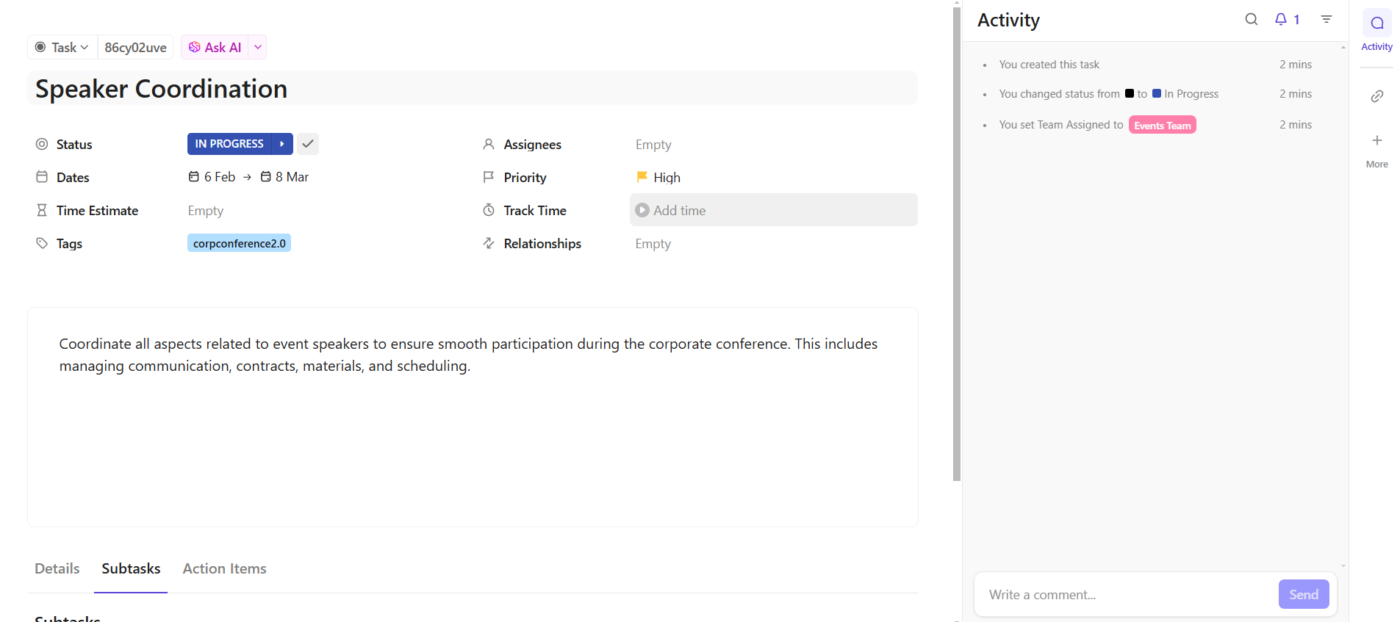
على سبيل المثال، عند التخطيط لمؤتمر شركة، يمكنك إنشاء قائمة ClickUp لكل مرحلة من مراحل الحدث — حجز المكان، وتنسيق المتحدثين، والتسويق، واللوجستيات. ضمن مهمة "تنسيق المتحدثين"، يمكن أن تشمل المهام الفرعية التواصل مع المتحدثين، وإنهاء العقود، وجمع مواد العرض التقديمي، وجدولة البروفات التقنية.
قالب ClickUp لتخطيط الأحداث
للبدء، يمكنك الاستفادة من نموذج ClickUp لتخطيط الأحداث لإدارة كل التفاصيل - من اختيار المكان ووضع الميزانية إلى قوائم الضيوف وتتبع الحضور - في مكان واحد.
يتضمن هذا النموذج ثلاث طرق عرض ClickUp سهلة الاستخدام للغاية تعمل بالسحب والإفلات لتخطيط فعال:
- عرض القائمة: نظم تفاصيل الفعالية والموارد والميزانيات في تنسيق منظم
- عرض اللوحة: تتبع الأولويات وسير العمل باستخدام لوحة بديهية على غرار Kanban
- عرض التقويم: إدارة الجداول الزمنية للأحداث والمواعيد النهائية باستخدام تقويم مرن
بالإضافة إلى ذلك، تساعد القوائم المحفوظة مسبقًا للأنشطة والمرافق والفعاليات السابقة للحدث والفواتير في تصنيف المهام والحفاظ على نظرة عامة واضحة على تقدم فعاليتك.
عزز التعاون من خلال ClickUp Chat
أحدثت Slack وأدوات الدردشة الأخرى تغييرًا في طريقة تواصل الفرق، وجعلت التعاون الفوري أمرًا معتادًا. ولكن بمرور الوقت، أصبحت هذه الأدوات مربكة، حيث تملأ الإشعارات المتكررة والمحادثات المتفرقة الشاشة وتشتت الانتباه عن العمل الفعلي.
فرق تخطيط الفعاليات تدرك ذلك جيدًا، حيث أن إدارة المحادثات المستمرة مع محاولة البقاء على اطلاع على المهام يمكن أن يشعر المرء وكأنه يخوض معركة خاسرة.
ClickUp Chat
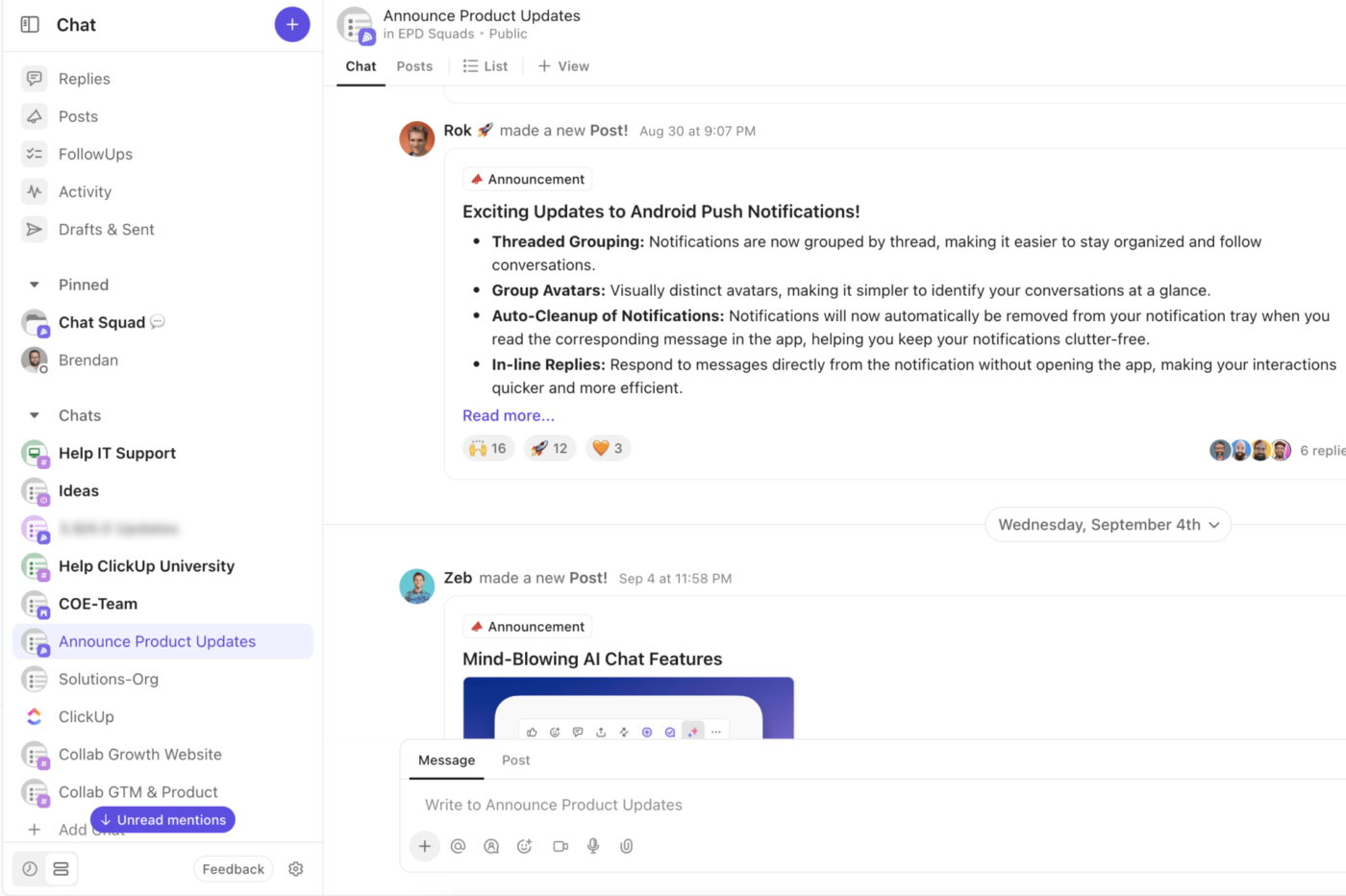
ادخل إلى ClickUp Chat، أداة التواصل المدمجة مباشرة في برنامج إدارة المشاريع ClickUp.
على عكس منصات الدردشة المستقلة، يربط Chat المحادثات بعملك. توجد كل محادثة في مكان وجود مهامك وقوائمك ومستنداتك، مما يحافظ على تزامن كل شيء.

هل تخطط لعقد مؤتمر؟ استخدم ClickUp Chat لمناقشة خيارات أماكن انعقاد المؤتمر، واربط الرسائل بمهام مثل تأمين العقود، وقم بتعيين متابعات لضمان قيام أعضاء الفريق باتخاذ الإجراءات اللازمة. لا داعي للنسخ واللصق أو البحث في قنوات متفرقة — فكل شيء يظل مرتبطًا بالسياق الصحيح.
تضيف SyncUps المزيد من القيمة. تتم هذه المكالمات الصوتية والمرئية مباشرةً داخل الدردشات، مما يسهل إجراء مكالمات سريعة لمراجعة الجداول الزمنية أو طرح الأفكار أو حل المشكلات في اللحظة الأخيرة دون مغادرة مساحة العمل.
🧠 حقيقة ممتعة: يتم التخطيط لعرض نصف الوقت في مباراة السوبر بول قبل سنوات، مع حساب كل ثانية، بما في ذلك خطط بديلة في حالة انقطاع التيار الكهربائي أو مشاكل الطقس.
راقب تقدم الفعالية ومؤشرات الأداء الرئيسية باستخدام لوحات معلومات ClickUp
توفر لوحات معلومات ClickUp نظرة سريعة على تقدم الحدث ومؤشرات الأداء الرئيسية (KPIs).
بفضل أكثر من 50 بطاقة قابلة للتخصيص تعرض حالة المهام وتتبع الميزانية وتقدم الجدول الزمني، يمكنك مراقبة البيانات في الوقت الفعلي وتحديد المجالات التي تحتاج إلى اهتمام بسرعة.
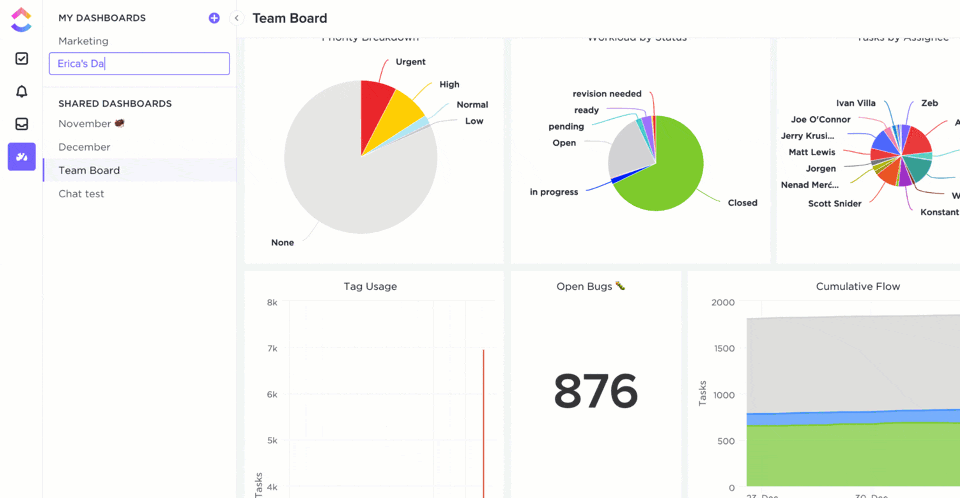
أثناء إدارة مؤتمر شركة، أنشئ لوحة معلومات لمراقبة جداول المتحدثين ولوجستيات المكان وجهود التسويق. يمكنك تتبع إنجاز المهام وإدارة التعديلات في اللحظة الأخيرة والتأكد من أن كل التفاصيل تسير وفق الجدول الزمني المحدد، مما يضمن تماسك الفريق بأكمله.
بسّط المهام المتكررة باستخدام ClickUp Automations
تقلل الأتمتة من الجهد اليدوي وتحد من الأخطاء، مما يتيح للفريق التركيز على الجوانب الاستراتيجية لتخطيط الفعاليات.
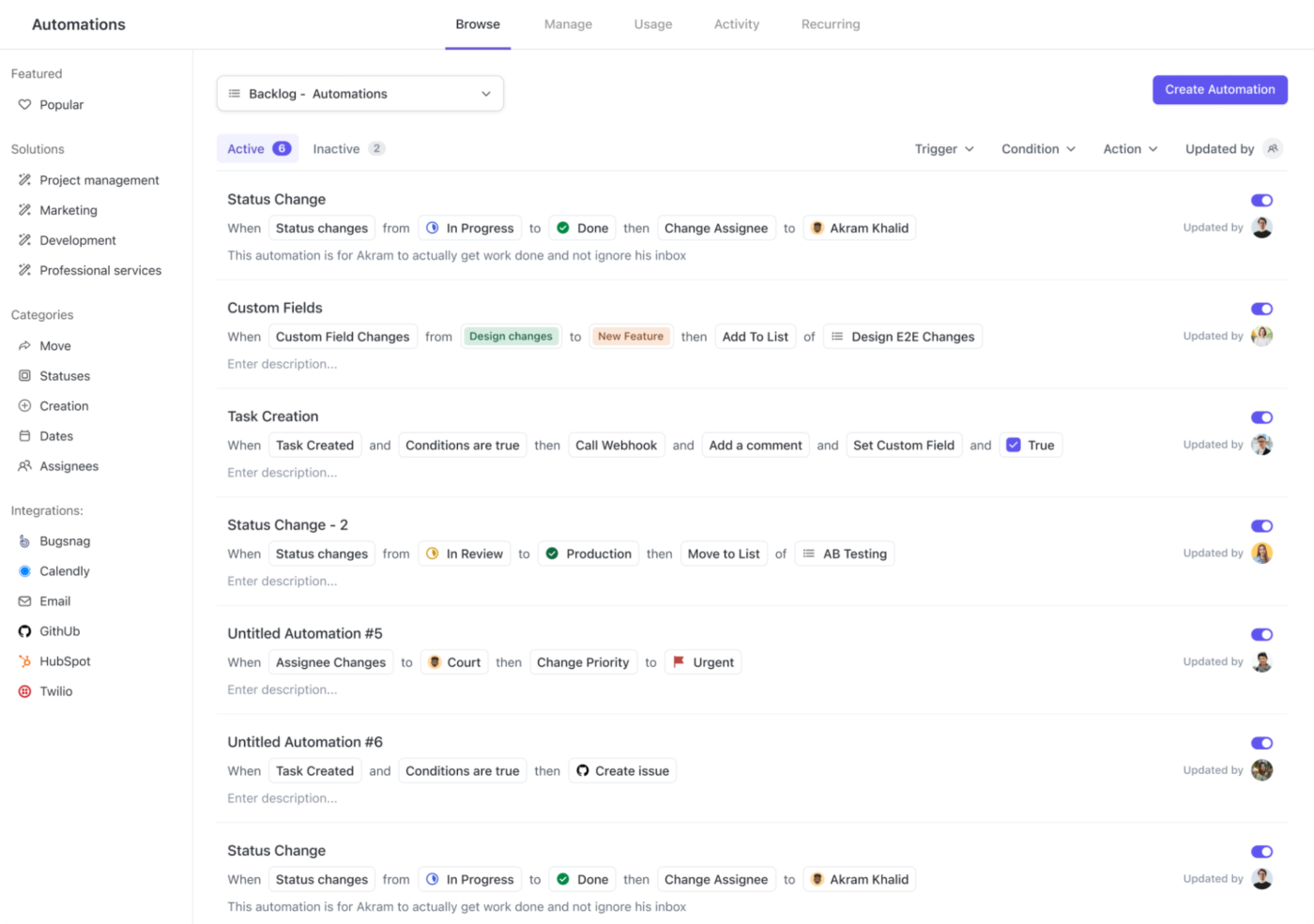
تتيح لك ClickUp Automations ما يلي:
- تعيين المهام بسهولة: قم تلقائيًا بتعيين مهام حجز المكان أو تنسيق المتحدثين إلى عضو الفريق المناسب عند إنشاء مهمة جديدة
- تتبع التقدم بسلاسة: قم بتحديث حالة المهام، مثل نقل "عقود الموردين" إلى "قيد التنفيذ" بمجرد إضافة تاريخ الاستحقاق
- لا تفوت أي موعد نهائي: أرسل تذكيرات أو إشعارات تلقائية للمواعيد المهمة مثل مواعيد تقديم الطعام أو تواريخ إعداد الأجهزة السمعية والبصرية
🔍 هل تعلم؟ مهرجان كومبه ميلا في الهند هو أكبر تجمع بشري، حيث يجذب أكثر من 100 مليون شخص في حدث واحد.
حسّن سير العمل باستخدام تكامل ClickUp
يتكامل ClickUp مع مجموعة من الأدوات الخارجية لإنشاء سير عمل سلس. تضمن هذه التكاملات تدفق البيانات بسلاسة بين المنصات، مما يبقي الجميع على منصة موحدة دون عناء التحديثات اليدوية.

فيما يلي بعض تكاملات ClickUp الرئيسية التي يمكنها تحسين عملية إدارة الأحداث لديك:
- تقويم Google: قم بمزامنة المهام والمواعيد النهائية مع تقويمك لضمان عدم إغفال أي شيء أثناء تخطيط الحدث
- Google Drive: أرفق العقود أو العروض التقديمية أو المواد التسويقية مباشرة بالمهام لتسهيل الوصول إليها أثناء التحضير للحدث
- Eventbrite: دمج قوائم الحضور أو معلومات التذاكر في المهام لتتبع التسجيلات واللوجستيات الخاصة بالحدث في مكان واحد
استفد من القوالب لإعداد الفعاليات بسرعة
يوفر ClickUp أيضًا قوالب شاملة لتخطيط الفعاليات لتسريع كل جانب من جوانب العملية.
إليك بعض النماذج التي يمكنك تجربتها:
🔗 بالنسبة للمشاريع الكبيرة والفعاليات التي تستمر لعدة أيام، قم بتنزيل نموذج ClickUp لتخطيط الفعاليات الكبيرة لتنسيق اللوجستيات وإدارة الجداول الزمنية بسلاسة
🔗 بالنسبة لوضع الميزانية والتخطيط المالي، استخدم نموذج ميزانية الفعاليات من ClickUp لتتبع النفقات ومراقبة التكاليف والالتزام بالميزانية
🔗 لتنظيم جداول الأحداث القائمة على السفر، تحقق من قوالب خط سير الرحلة لإنشاء خطط سفر منظمة وجداول يومية وتفاصيل الأنشطة
🔗 لتنظيم المؤتمرات والاجتماعات، استخدم قوالب جدول أعمال المؤتمرات لتخطيط جلسات المتحدثين وحلقات النقاش وأوقات الاستراحة بفعالية
المخاطر الرئيسية لسوء إدارة مشاريع الفعاليات
يمكن أن تؤدي الإدارة السيئة لمشاريع الفعاليات إلى إفشال أفضل الأفكار، مما يؤدي إلى أخطاء مكلفة وتجربة غير مرضية للحضور. غالبًا ما تنشأ هذه المخاطر عن التخطيط غير الكافي وسوء التواصل والافتقار إلى تدابير الطوارئ.
دعنا نلقي نظرة على بعض الأمثلة:
- تجاوز الميزانية: يؤدي سوء إعداد الميزانية والتحكم في التكاليف إلى تجاوز الأموال المخصصة ❌
- خسارة الإيرادات: انخفاض عدد الحضور وفشل الرعاية يقللان من الربحية ❌
- المشكلات اللوجستية: قد يؤدي عدم كفاءة إدارة المكان والتنسيق والنقل إلى حدوث اختناقات ❌
- الأعطال الفنية: تؤدي التكنولوجيا غير الموثوقة ونقص أنظمة النسخ الاحتياطي والدعم غير الكافي إلى تعطيل الفعالية ❌
- تضرر الصورة العامة: قد تؤدي الإخفاقات الكبيرة إلى الإضرار بسمعة المؤسسة ومصداقيتها ❌
- مشكلات التحكم في الحشود: قد يؤدي سوء الأمن والإدارة إلى وقوع حوادث ❌
- فشل الاستجابة لحالات الطوارئ: قد يؤدي عدم الاستعداد للحوادث الطبية أو الأمنية إلى تفاقم الأزمات ❌
- عدم الامتثال للوائح التنظيمية: قد يؤدي انتهاك متطلبات السلامة والمتطلبات القانونية إلى فرض غرامات ودعاوى قضائية ❌
🔍 هل تعلم؟ غالبًا ما يدرج منظمو الفعاليات المحترفون "تأمين اليونيكورن" في عقودهم. وهو مصطلح غريب في هذا المجال يشير إلى تغطية الاضطرابات غير المتوقعة حقًا.
أفضل الممارسات في إدارة مشاريع الفعاليات
تتطلب إدارة مشاريع الفعاليات الناجحة تخطيطًا واضحًا ومراقبة استباقية. الآن بعد أن أصبحت على دراية بالمخاطر، أصبح من السهل تنفيذ أفضل الممارسات، وهو أمر أساسي لضمان سير الفعالية بسلاسة والحفاظ على مصداقية مؤسستك.
فيما يلي بعض أفضل الممارسات لإدارة مشاريع الفعاليات بفعالية:
- شكّل فريقًا متخصصًا: كوّن مجموعة متنوعة من الخبراء في مجالات التخطيط والتسويق واللوجستيات والعمليات والدعم الفني ✅
- أعط الأولوية لتجربة الحضور: صمم كل عنصر من عناصر الحدث بهدف جذب انتباه جمهورك وإرضائهم وإسعادهم ✅
- التواصل الفعال: حافظ على قنوات اتصال مفتوحة مع جميع الأطراف المعنية، بما في ذلك أعضاء الفريق والموردين والحضور، لضمان تماسك الجميع ✅
- تنفيذ خطة تسويق استراتيجية: الوصول إلى جمهورك المستهدف وإثارة اهتمامهم من خلال الترويج المركّز والرسائل الواضحة ✅
- اعتمد قائمة مراجعة لتخطيط الفعاليات: استخدم قائمة مراجعة مفصلة لتجميع جميع المهام والنتائج المطلوبة، وضمان عدم إغفال أي شيء ✅
مؤشرات الأداء الرئيسية للفعاليات
إن معرفة مؤشرات الأداء الرئيسية التي يجب تتبعها هو السر لفهم الأداء الحقيقي لفعاليتك.
دعنا نستعرض أهمها والتي تستحق اهتمامك.
- الالتزام بالميزانية: تتبع الإنفاق الفعلي مقارنة بالميزانية المخططة لضمان الكفاءة المالية
- الالتزام بالجدول الزمني: راقب إنجاز المهام وتحقيق الإنجازات المهمة للحفاظ على سير المشروع وفقًا للجدول الزمني المحدد
- الحضور والمشاركة: قارن الحضور الفعلي بالأرقام المتوقعة وقم بتقييم مستويات المشاركة لقياس تأثير الحدث
- المقاييس المالية: قم بتقييم الإيرادات ونجاح الرعاية وكفاءة الميزانية من خلال: الإيرادات المحققة إيرادات الرعاية التكلفة لكل مشارك تباين الميزانية عائد الاستثمار (ROI)
- الإيرادات المحققة
- إيرادات الرعاية
- التكلفة لكل مشارك
- الاختلاف في الميزانية
- عائد الاستثمار (ROI)
- مؤشرات الأداء الرئيسية للتسويق: تقييم فعالية الترويج من خلال: التفاعل على وسائل التواصل الاجتماعي حركة المرور على الموقع الإلكتروني وتوليد العملاء المحتملين استخدام رموز الخص
- التفاعل على وسائل التواصل الاجتماعي
- حركة المرور على الموقع الإلكتروني وتوليد العملاء المحتملين
- استخدام رمز الخصم
- الإيرادات المحققة
- إيرادات الرعاية
- التكلفة لكل مشارك
- الاختلاف في الميزانية
- عائد الاستثمار (ROI)
- التفاعل على وسائل التواصل الاجتماعي
- حركة المرور على الموقع الإلكتروني وتوليد العملاء المحتملين
- استخدام رمز الخصم
📖 اقرأ أيضًا: أدوات الذكاء الاصطناعي لإدارة الفعاليات بشكل أكثر سلاسة
خطط بشكل كبير وتخلص من التوتر مع ClickUp
تتمثل إدارة المشاريع الفعالة في المزج بين الإبداع والتنظيم والقدرة على التكيف لتحقيق نتائج لا تُنسى.
كل التفاصيل مهمة، ومع تطور التكنولوجيا وتغير توقعات الجمهور، فإن امتلاك الأدوات المناسبة يضمن لك أن تكون دائمًا على استعداد لتقديم أفضل ما لديك.
وهنا يأتي دور ClickUp، حيث يساعد منظمي الفعاليات على "تحديد" جميع الخيارات الصحيحة باستخدام ClickUp Tasks لتبسيط سير العمل، وClickUp Automations لتوفير الوقت، وClickUp Chat للتواصل السلس.
من تتبع الميزانيات إلى إدارة التغييرات في اللحظة الأخيرة، يحافظ ClickUp على تزامن كل شيء.
اشترك في ClickUp اليوم وركز على تقديم تجارب لا تُنسى!
